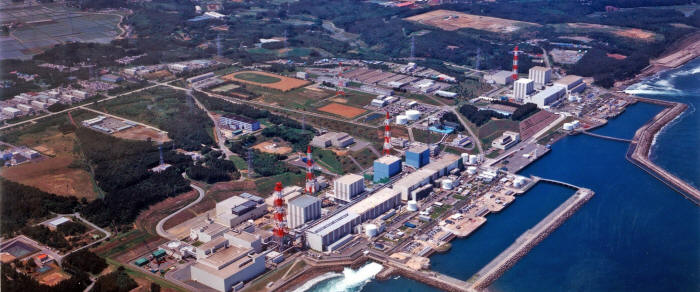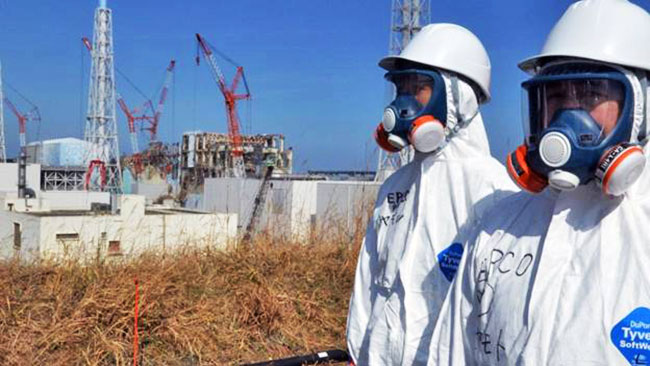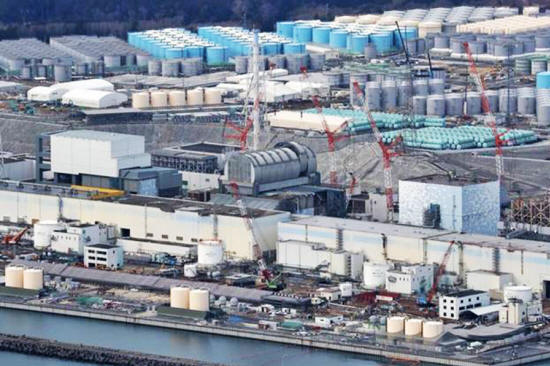|

by Mark Sircus
October 19,
2018
from
DrSircus Website

In July of 2005 the National Academy of Sciences came to the
conclusion that the preponderance of scientific evidence shows that
even very low doses of radiation pose a risk of cancer or other
health problems and there is no threshold below which exposure can
be viewed as harmless. [1]
Many doctors, however,
generally assumed that low levels of radiation are harmless since
they produced no immediately observable effects.
They even assume high
levels of radiation are harmless and thus expose infants to CAT
scans.

Radiation is poison.
We are slowly killing off
our world with,
For a quick kill all we
need is a nuclear war; and it does seem that many politicians in
America would like to expose all of us to killer radiation with a
war with Russia.
Radiation is death, it
means cancer. It is hard to treat...
Fukushima
Forever
At the top of the toxic list of nuclear problems
is Fukushima, a problem that will
never go away.
The Fukushima nuclear
plant meltdown disaster,
"is not over and will
never end," warns Dr.
Helen Caldicott, Nobel Peace
Prize nominee and holder of 21 honorary doctorate degrees.
The owner of the
Fukushima nuclear plant, destroyed
by an earthquake and tsunami
more than seven years ago, said
water treated at the site still
contains radioactive materials that for years it has insisted had
been removed.
The admission by Tokyo
Electric Power could ruin its chances of releasing the water
into the ocean, a move the nuclear regulator says is safe, but which
local fishermen oppose.
Just in Fukushima alone the government and Tokyo Electric Power
Company Holdings Inc (TEPCO)
is under pressure to
dump 920,000 tons of
tritium-containing water, which are stored in some 680 tanks within
the premises of the plant into the sea.
This water is severely
contaminated with 62.2
becquerels per liter of
Iodine 129, far higher than the 9
becquerel legal limit, was found in the water filtered by the
Advanced Liquid Processing System used to remove various types
of radioactive materials.
Iodine 129 has a
half-life of 15.70 million years.
TEPCO said in early October that studies found the water still
contains other elements, including radioactive iodine, cesium and
strontium.
About 161,000 tons of the
treated water has 10 to 100 times the limit for release into the
environment, and another 65,200 tons has up to nearly 20,000 times
the limit, TEPCO said.

Contaminated water is stored in large tanks
at the crippled Fukushima No. 1 nuclear power plant.
(Asahi Shimbun file photo)
The crippled reactors at the plant are still generating huge amounts
of water contaminated with radiation every day.
Tons of groundwater
percolating into the damaged reactor buildings as well as water
being injected into the reactors to cool the melted fuel are
constantly becoming contaminated.
There is no treatment for
this water, no place to put it except into the ocean but better to
not talk or even think about such things.
Too Much Radiation
Fukushima is just one of many radioactive hot spots on our earth yet
by far it is the hottest.
Readings inside the
containment vessel of reactor no. 2 are as high as
530 Sieverts per hour, a dosage
that would be fatal dozens and dozens of times over if a human were
to be exposed to it.
The previous high was a
still very fatal rate of 73
Sieverts per hour.
The highest radiation levels ever measured at
Chernobyl were 300 Sieverts per
hour; an incomprehensibly high dose which can kill a man almost
instantly. The new record at Fukushima of 530 Sieverts per hour is
70% higher than that of Chernobyl.
The 530 Sievert reading
was recorded some distance from the melted fuel, so in reality it
could be 10 times higher than recorded, said Hideyuki Ban,
co-director of Citizens' Nuclear Information Center.
To put this in perspective, radiation is usually measured in
thousandths of a Sievert, called millisieverts. For example, most
people receive around 2.4 millisieverts per year from background
radiation, or only 0.0002739726 per hour.
According to the
Kyodo news agency, the institute
estimates that exposure to one Sievert of radiation could lead to
infertility, loss of hair and cataracts.
One Sievert is enough to
cause radiation sickness and nausea; 5 Sieverts would kill half
those exposed to it within a month, and a single dose of 10 Sieverts
would prove fatal within weeks.
How Come
Doctors don't say More about Radiation Dangers?
Because they are among the primary users of nuclear radiation, using
it for all kinds of dangerous tests.
A single
CT scan of the chest is equal to
about 350 standard chest X-rays. They are using radiation, a
cause of cancer, to try to treat cancer.
Dr. Edward Golembe, who directs a hyperbaric oxygen chamber
at Brookdale University Hospital in Brooklyn, said he had treated
serious radiation injuries to the jaw and called them,
"a horrible, horrible
thing to see."
When we deal with
radiation we deal with death for it is the death principle that
doctors are trying to harness with terrible results. Most people who
employ radiation in their treatments for cancer suffer horribly but
some worse than others.
According to the Times,
"Americans today
receive far more medical radiation than ever before.
The average lifetime
dose of diagnostic radiation has increased sevenfold since 1980,
and more than half of all cancer patients receive radiation
therapy."
Radiotherapy can leave patients
with a lifetime of suffering and their life expectancy severely
shortened.
The New York Times
said,
"These interventions
can be just as brutal on the patient as they are on a tumor."
Thousands of cancer
survivors have developed terrible conditions as a result of the
radiotherapy treatment that helped save them.
What to do about
increasing radiation exposure?
Dr. Brownstein writes,
"If there is enough
inorganic, non-radioactive iodine in our bodies, the radioactive
fallout has nowhere to bind in our bodies. It will pass through
us, leaving our bodies unharmed.
It is important to
ensure that we have adequate iodine levels BEFORE this fallout
hits."
Everyone should be making
sure that they are taking enough minerals because
radioactive substances mimic their non-radioactive mineral
substances.
Strontium mimics calcium,
for example, making it extremely dangerous to all life forms once it
is absorbed.
Drink lots
of iodine,
sodium bicarbonate, magnesium and
start off each day drinking a glass of ultra-pure edible clay.
Edible clay is one of the most
basic detoxification substances.
It helps make sure
absorbed radioactive particles pass through instead of into us.
When was the last time
you remember your doctor telling you to take magnesium or any of
these other substances, or even sulfur to reduce the risk that our
exposure leading to cancer.
The kidneys are usually the first organs to show chemical damage
upon uranium exposure. Old military manuals suggest doses or
infusions of sodium bicarbonate to help alkalinize the urine if this
happens. This makes the uranyl ion less kidney-toxic and promotes
excretion of the uranium-carbonate complex.
The oral administration
of sodium bicarbonate diminishes the severity of the changes
produced by uranium in the kidneys.
Chronic oxidative stress is the main cause of the late
post-radiation effects, including cancer. [2]
Cellular exposure to
ionizing radiation leads to oxidizing events that alter atomic
structure through direct interactions of radiation with target
macromolecules. Further, the oxidative damage may spread from the
targeted to neighboring, non-targeted bystander cells.
In irradiated cells,
levels of these reactive species may be increased due to
perturbations in oxidative metabolism and chronic inflammatory
responses, thereby contributing to the long-term effects of exposure
to ionizing radiation on genomic stability. [3]
Has your doctor told you that taking only 200 micrograms of selenium
a day will reduce your chance of dying of cancer by 50 percent?
The absorption of ionizing radiation by living cells can directly
disrupt atomic structures, producing chemical and biological
changes. It can also act indirectly through radiolysis of water,
thereby generating reactive chemical species that may damage nucleic
acids, proteins and lipids.
Oxidative stress contributes to many pathological conditions and
diseases, including,
-
cancer
-
neurological
disorders
-
atherosclerosis
-
hypertension
-
ischemia/perfusion
-
diabetes
-
acute respiratory
distress syndrome
-
idiopathic
pulmonary fibrosis
-
chronic
obstructive pulmonary disease
-
asthma [4]
Glutathione synthetase
requires glutamyl cysteine, glycine, ATP, and magnesium ions to form
glutathione.
There is a direct
relationship between cellular magnesium, GSH/GSSG ratios, and tissue
glucose metabolism. Magnesium deficiency causes glutathione
deficiency.
The higher the exposure
the more glutathione is needed.
Hydrogen
Medicine
Reducing the amount of oxidative stress, we are constantly faced
with, is one of the most important things we can do for our health.
Nothing will take down oxidative stress like hydrogen inhalation.
Cosmic radiation is known to induce DNA and lipid damage associated
with increased oxidative stress and remains a major concern in space
travel.
Hydrogen has potent
antioxidant and anti-inflammatory activities.
Scientists hypothesize
that hydrogen administration to the astronauts by either inhalation
or drinking hydrogen-rich water may potentially yield a novel and
feasible preventative/therapeutic
strategy to prevent radiation-induced adverse
events. [5]
Conclusion
Every dose of radiation increases the chances of getting cancer
sooner or later in one's life.
Chemotherapy also causes cancer
because of its toxicity. Given enough time, cancer will develop
whenever there is a proliferation of damaged cells and when oxygen
levels fall far enough:
-
when cells are
damaged
-
when their cell
wall permeability changes
-
when toxins and
free radicals build up
-
when the
mitochondria lose functionality in terms of energy ATP
production
-
when pH shifts to
the acidic in cells
-
when essential
gasses like carbon dioxide are not present in sufficient
concentrations
-
when essential
nutrients are absent, and stress levels are high enough,
...cells will eventually
decline into a cancerous condition.
Radiation of course helps
all of these processes take us to an early grave.
References
[1] The linear no
threshold modelor LNTM is a model of damage done by radiation.
This model assumes that the response to radiation exposure is
linear and that this linear relationship continues to very small
doses, that is to say that there is no threshold of exposure
below which the response ceases to be linear. When it comes to
radiation if a particular dose of radiation is found to produce
one extra case of a type of cancer in every thousand people
exposed, the LNTM predicts that one thousandth of this dose will
produce one extra case in every million people so exposed, and
that one millionth of this dose will produce one extra case in
every billion people.
[2] Int J Radiat Biol. 2015 Jan;91(1) Ionizing radiation-induced
oxidative stress, epigenetic changes and genomic instability:
the pivotal role of mitochondria.
[3] Cancer Lett. 2012 Dec 31; 327(0): 48-60. Ionizing
radiation-induced metabolic oxidative stress and prolonged cell
injury
[4] World Allergy Organ J. 2012 Jan; 5(1): 9-19. Oxidative
Stress and Antioxidant Defense
[5] Med Hypotheses. 2011 Jan;76(1):117-8. Hydrogen therapy may
reduce the risks related to radiation-induced oxidative stress
in space flight.
| 



